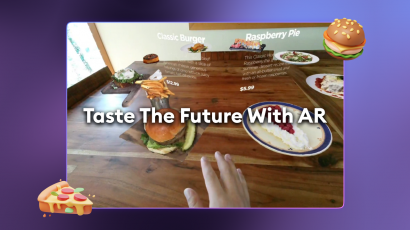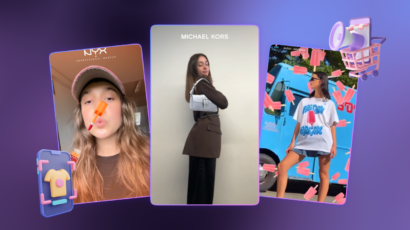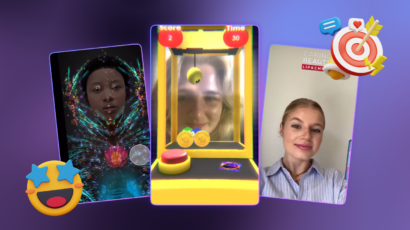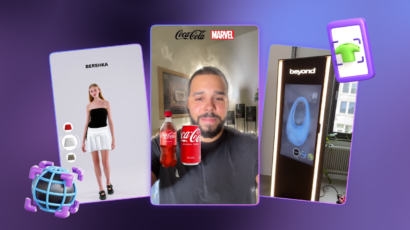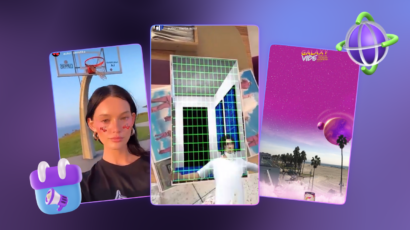In this era of digital transformation with countless possibilities, Augmented Reality (AR) is rapidly changing and reshaping marketing strategies in almost every industry. The food and beverage industry is no exception. The abilities of Augmented reality in the food and beverages industries are elevating this field to a whole new level.
According to a report from Market Research Future, the AR market size will hit USD 461.25B at a CAGR of 41.50% by 2030. No wonder so many industries are exploring themselves through AR prospects.
AR can help the food and beverage industry to increase brand equity, gain customer loyalty, and support new revenue streams. AR also can be used to enhance the consumer experience by providing brand-specific content or features that make the product more interesting or desirable.
Let’s walk through the successful cases of using Augmented Reality in the food and beverages industry and analyze how AR can be a practical and significant tool for marketing innovation.
Break Language Barriers with AR-Powered Menu’s
AR can address several obstacles by offering AR food menus.
- Improving customer engagement: AR interactive menus can appeal to customers’ visual senses, keeping them engaged in the ordering process.
- Increasing order accuracy: Using AR technology to display realistic images of menu items can help customers get a better sense of what they are ordering, resulting in fewer errors and greater satisfaction with the final meal.
- Reducing training costs: AR can help reduce the need for staff training by allowing new employees to learn about menu offerings through visualization.
- Enhancing brand image: Using AR to create visually striking and unique menu displays can make a company stand out among competitors.
- Upselling and promoting new items: AR can help highlight new or under-selling menu items, increasing visibility, and sales.
Some people have difficulty making decisions about what they should eat, or are interested in learning more about products. Product visualization is a way for customers to understand what they are ordering, making it easier for them to make those decisions. Aiding this process with AR can enhance in-store experiences. This allows food and beverage companies’ products – from ingredients to finished goods – to be experienced on another level.
With AR, food and beverage companies can create interactive experiences that let customers see how products look, feel or taste from the convenience of their smartphones. It is an easily accessible, simply understandable feature with numerous benefits. From trust to loyalty, more personalization and information for consumers equals more ROI for the brand.
AR Portals: a Spectacular Way To Engage Customers
Customer engagement is the chief factor for any brand in any industry. Every brand is trying to find impressive ways to engage its consumers. Augmented reality allows brands to differentiate themselves effectively.
To increase customer engagement and create memorable experiences, McDonalds created an AR portal effect. The effect allows users to place a virtual McDonalds-themed building right in front of them, in which they can walk and have a 3D sight of space. This feature gives the possibility to fully experience the brand’s vibe.
Businesses can use AR Portal features to fully immerse consumers into the brand’s world, introduce and involve them in the brand identity.
Utilising AR to Build Strong Brand Loyalty and Increase Awareness
To celebrate the coming of summer and the revival of large-scale events, M&M’s created an interactive ‘Music Lounge’ that users can explore by stepping inside it. Guests can make their own beats, share them with others and collect festival-related virtual goods while they are enjoying the experience.
The experience created by the combination of a mini-game, image tracker, and face filter helped to raise brand awareness. M&M’s also was aiming to refresh its brand identity and offer something new and special.
Through the use of AR, businesses can create unique and memorable experiences that can help them stand out from their competitors. Thus, AR can differentiate brands, giving a possibility to try out new features, and keep customers interested at every turn, strengthening the bond between a brand and its audience and making it more appealing to others.
Furthermore, it potentially opens the door for the company to reach an underserved audience segment. With AR businesses appear more innovative and forward-thinking within their industry.
Forming Emotional Connections With AR Gamification
With the help of AR technology, Coopers Brewery created a webAR mini-game that teaches customers how to properly pour and enjoy their beer, additionally unlocking the flavor, with over $25,000 of prizes to be won.
In this case, with webAR abilities, the company was able to provide engaging and enjoyable experiences that help customers form an emotional connection with a brand, motivating them to purchase its products. The Coopers’ AR game is a great example of how brands can use AR to create an appealing experience for their customers by thinking outside of the box.
Mini-games enable businesses to interact with consumers through various communication channels and foster an organic referral network. In this particular game, players were urged to invite their friends or bring a companion, resulting in a viral impact and attracting clients outside of the targeted segment.
It’s also one of the examples of how brands are leveraging technology to engage with their target audience in innovative ways that allow them to protrude.
Gamification is an already well-known tool and practice that marketers use for engagement. Mini-games are an absorbing way for customers to interact with products.
How Burger King Used Augmented Reality to Grill the Competition
It is indeed impressive when marketers create insightful campaigns for the brand, especially with AR. But how about campaigns that go beyond the brand?
Once again, Augmented Reality for food and beverages industry can make anything happen.
Burger King’s brilliant use of AR to place its ads over those of competitors is one way that the company outshone its rivals.
They incorporated their longstanding selling point of flame-broiled burgers through the flame broiling of other companies’ marketing materials. The AR app that the brand created also includes payment features that put Whopper products directly in a customer’s cart for free, encouraging them to make additional purchases – like fries and a Coke.
Burger kind successfully built excitement for their product launch by offering something free and then encouraging users to pay it forward with purchases of their own. The app is a great way to bring new customers into the fold, especially with its fun and interactive features.
It’s also a good way for existing customers to get more out of their experience with Burger King, which helps them feel more engaged with the brand.
Creating Uniquely Memorable Experiences to Increase Sales
Heineken created an AR filter to offer something unique and memorable to its consumers.
This AR experience combines augmented world and image tracker categories. The feature offers a distinctive and innovative way of promoting sales by sticking out from the competitors.
With AR, Heineken created interactive marketing experiences engaging potential clients and increasing sales.
Furthermore, this technology allows brands to track people’s interactions with their products, which makes it possible to measure and understand the effects of AR on sales. This is a great way to showcase your product and provide customers with an interactive experience.
How AR is Elevating The Industry To Another Level
AR has the potential to solve many of the problems that food and beverage companies face today. From creating new products and improving existing ones, to improving sales and increasing engagement. This technology can deliver more personalized messages and this is exactly what this field is aiming for.
AR is much more than just a technology trend, it is the way to become more innovative and break new ground.
Using Augmented Reality in food and beverages industry has the ability to elevate brands into industry leaders as they use cutting-edge AR tools in their marketing efforts. By doing so, they may not only address the problems those businesses are now experiencing, but also invent entirely original solutions, establish new market trends, and reap a wide range of additional advantages that will help their businesses flourish as a whole.
The potential for AR is huge, and we’re only just scratching the surface of what it can do. As more people adopt AR technology, it will become even more useful for businesses in a variety of industries.
If you want to step towards development and innovation, schedule a talk with us. Crosscreators team is always pleased to assist you, from ideation to creation.
